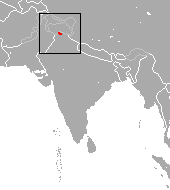| Kashmir gray langur | |
|---|---|
| Scientific classification | |
| Domain: | Eukaryota |
| Kingdom: | Animalia |
| Phylum: | Chordata |
| Class: | Mammalia |
| Order: | Primates |
| Suborder: | Haplorhini |
| Infraorder: | Simiiformes |
| Family: | Cercopithecidae |
| Genus: | Semnopithecus |
| Species: | S. ajax
|
| Binomial name | |
| Semnopithecus ajax | |

| |
| Kashmir gray langur range | |
The Kashmir gray langur (Semnopithecus ajax) is an Old World monkey, one of the langur species. It is a leaf-eating monkey.[2]
It has been reported from Jammu and Kashmir and Himachal Pradesh in northwestern India but evidence indicates it only occurs in the Chamba Valley in Himachal Pradesh. Because of its restricted range, fragmented population and threats from human agriculture and development activities it is listed as Endangered in the IUCN Red List.[1] In Pakistan it occurs in Machiara National Park.[3]
It was formerly considered a subspecies of Semnopithecus entellus and is one of several Semnopithecus species named after characters from The Iliad, along with Semnopithecus hector and Semnopithecus priam.[4]
- ^ a b c Kumar, A.; Singh, M.; Anandam, M.; Ahuja, V.; Kumara, H.N. & Molur, S. (2020). "Semnopithecus ajax". IUCN Red List of Threatened Species. 2020: e.T39833A17943210. doi:10.2305/IUCN.UK.2020-2.RLTS.T39833A17943210.en. Retrieved 17 January 2022.
- ^ a b Groves, C. P. (2005). Wilson, D. E.; Reeder, D. M. (eds.). Mammal Species of the World: A Taxonomic and Geographic Reference (3rd ed.). Baltimore: Johns Hopkins University Press. p. 174. ISBN 0-801-88221-4. OCLC 62265494.
- ^ Minhas, R. A.; Ahmed, K. B.; Awan, M. S.; Dar, N. I. (2010). "Social organization and reproductive biology of Himalayan grey langur (Semnopithecus entellus ajax) in Machiara National Park, Azad Kashmir (Pakistan)". Pakistan Journal of Zoology. 42: 143–156.
- ^ Groves, C. P. (2005). Wilson, D. E.; Reeder, D. M. (eds.). Mammal Species of the World: A Taxonomic and Geographic Reference (3rd ed.). Baltimore: Johns Hopkins University Press. pp. 174–175. ISBN 0-801-88221-4. OCLC 62265494.
